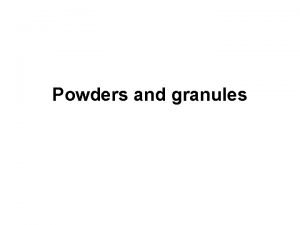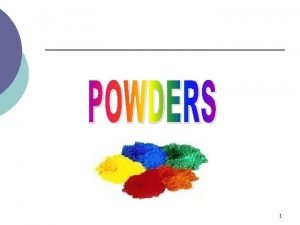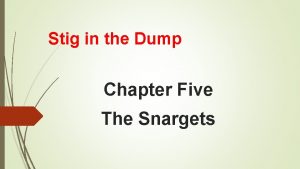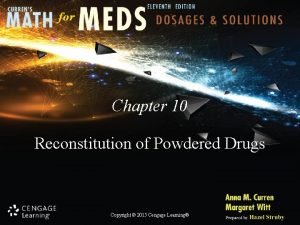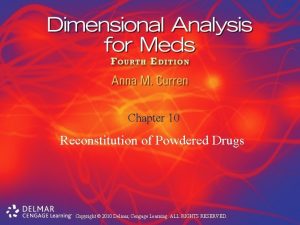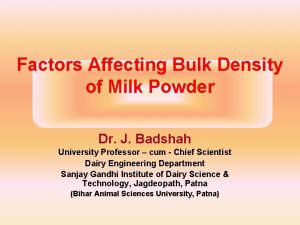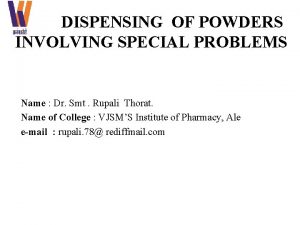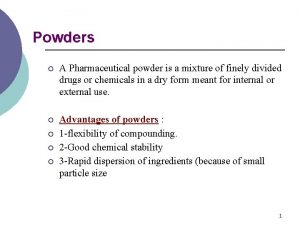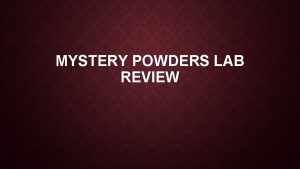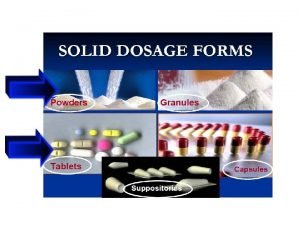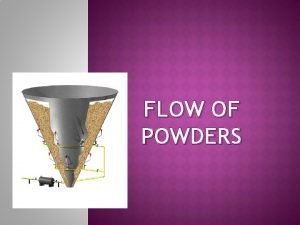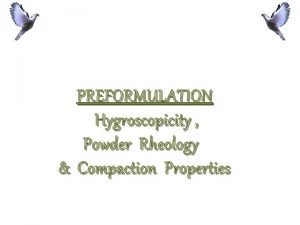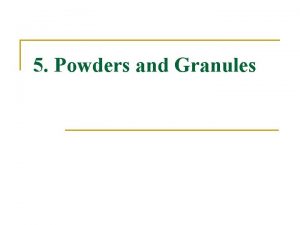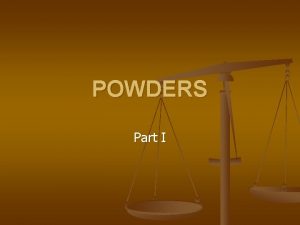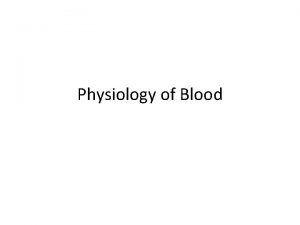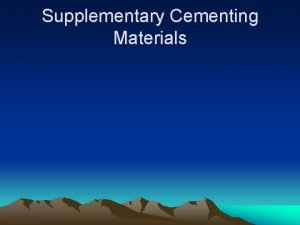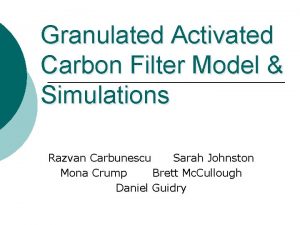Powders and granules POWDERED AND GRANULATED PRODUCTS AS














- Slides: 14

Powders and granules

POWDERED AND GRANULATED PRODUCTS AS DOSAGE FORMS • The term 'powder' when used to describe a dosage form describes a formulation in which a drug powder has been mixed with other powdered excipients to produce the final product. • The function of the added excipients depends upon the intended use of the product. Coloring, flavouring and sweetening agents, for example, may be added to powders for oral use. • Conventionally, the title 'powder' should be restricted to powder mixes for internal use, and alternative titles are used for other powdered formulations, e. g. dusting powders, which are for external use.

Granules which are used as a dosage form consist of powder particles that have been aggregated to form a larger particle, which is usually 2 -4 mm in diameter. Powdered and granulated products are traditionally dispensed as: • bulk powders or granules for internal use ( rehydration , laxatives ) • divided powders or granules (i. e. single preparations) for internal use or external use ( douches powder, tooth cleaning powders ) • dusting powders for external use • antibiotic syrups to be reconstituted before use • powders for reconstitution into injections • dry powder inhalers.

Advantages of powdered and granulated products 1. Solid preparations are more chemically stable than liquid ones. The shelf-life of powders for antibiotic syrups, for example, is 2 -3 years, but once they are reconstituted with water it is 1 -2 weeks. The instability observed in liquid preparations is usually the primary reason for presenting some injections as powders to be reconstituted just prior to use. 2. Powders and granules are a convenient form in which to dispense drugs with a large dose. The dose of Compound Magnesium Trisilicate Oral Powder is 1 -5 g, and although it is feasible to manufacture tablets to supply this dose it is often more acceptable to the patient to disperse a powder in water and swallow it. 3. Orally administered powders and granules of soluble medicaments have a faster dissolution rate than tablets or capsules, as these must first disintegrate before the drug dissolves.

Disadvantages of powdered and granulated products 1. Bulk powders or granules are far less convenient for the patient to carry than a small container of tablets or capsules, and are as inconvenient as liquid preparations, such as mixtures. Modern packaging methods for divided preparations, such as heat-sealable laminated sachets, mean that individual doses can be conveniently carried. 2. The masking of unpleasant tastes may be a problem with this type of preparation. 3. Bulk powders or granules are not suitable for administering potent drugs with a low dose. This is because individual doses are extracted from the bulk using a 5 m. L spoon. This method is subject to such variables as variation in spoon fill. 4. Powders and granules are not a suitable method for the administration of drugs which are inactivated in, or cause damage to, the stomach; these should be presented as enteric-coated tablets, for example.

DISPENSED PREPARATIONS • Bulk powders • The mixed ingredients are packed into a suitable bulk container, such as a wide-mouthed glass jar. Because of the disadvantages of this type of preparation the constituents are usually relatively nontoxic medicaments with a large dose, e. g. magnesium trisilicate and chalk, as present in Compound Magnesium Trisilicate Oral Powder (For the relief of Dyspepsia and excessive acidity ). • Relatively few proprietary examples exist, although many dietary/food supplements are packed in this way. Compound Magnesium Trisilicate Oral Powder

• • Divided powders are similar formulations to bulk powders but individual doses are separately wrapped. Traditionally, single doses were wrapped in paper. • This was unsatisfactory for most products, particularly if the ingredients were hygroscopic, volatile or deliquescent. Modern packaging materials of foil and plastic laminates have replaced such paper wrappings because they offer superior protective qualities and are amenable to use on high-speed packing machines. • Effervescent powders can now be packed in individual dose units because of the protective qualities of laminates. Such powders contain, for example, sodium bicarbonate and citric acid, which react and effervesce when the patient adds the powder to water to produce a draught. It is important to protect the powder from the ingress of moisture during manufacture and on subsequent storage to prevent the reaction occurring prematurely. • All powders and granules should be stored in a dry place to prevent deterioration due to ingress of moisture. Even if hydrolytic decomposition of susceptible ingredients does not occur, the particles will adhere and cake, producing an inelegant, often unusable product.

• Bulk granules • One disadvantage of bulk powders is that, because of particle size differences, the ingredients may segregate , either on storage in the final container or in the hoppers of packaging machines. If this happens the product will be non-uniform and the patient will not receive the same dose of the ingredients on each occasion. This can be prevented by granulating the mixed powders. • Bulk granules therefore contain similar medicaments to powders, i. e. those with low-toxicity, high dose drugs. Methylcellulose Granules, for example, are used as a bulk-forming laxative and have a dose of 1 -4 g daily. Many proprietary preparations contain similar bulk-forming laxatives. • • Divided granules • • • Methylcellulose Granules These are granulated products in which sufficient for one dose is individually wrapped. Effervescent granules can be formulated and presented in this manner. The comments on packaging materials discussed under Divided powders above are also equally pertinent to divided granules.

Talc dusting powder • Dusting powders • Dusting powders contain ingredients used for therapeutic, prophylactic or lubricant purposes and are intended for external use. Only sterile dusting powders should be applied to open wounds. Such preparations should be prepared using materials and methods designed to ensure sterility and to avoid the introduction of contaminants and the growth of microorganisms. • Dusting powders for lubricant purposes or superficial skin conditions need not be sterile but they should be free from pathogenic organisms. As minerals such as talc and kaolin may be contaminated at source with spores of organisms causing tetanus and gangrene, these should be sterilized before they are incorporated into the product. Talc dusting powder is a sterile cutaneous powder containing starch and purified talc in which the talc is sterilized before incorporation with the starch, or the final product is subject to a suitable terminal sterilization procedure.

• Dusting powders • Dusting powders are normally dispensed in glass or metal containers with a perforated lid. The powder must flow well from such a container, so that they can be dusted over the affected area. The active ingredients must therefore be diluted with materials having reasonably good flow properties, e. g. purified talc or maize starch. • Hexachlorophane Dusting Powder contains an antibacterial agent and Talc Dusting Powder is used as a lubricant to prevent chafing. Proprietary products are available, usually for the treatment of bacterial or fungal infections, e. g. Canesten Powder (clotrimazole) is used as an antifungal agent and CX Powder (containing hlorhexidine acetate) is used as a general skin disinfectant.

• • Insufflations are medicated powders which are blown into regions such as the ear, nose and throat using an insufflator. • The use of traditional insufflations declined because they were not very acceptable, being more inelegant and less convenient to apply than other topical preparations. A second problem was that if the powder contained a drug that had systemic activity it was difficult, with the conventional insulator, to ensure that the same dose was delivered on each occasion. • Some potent drugs are now presented in this way because they are rapidly absorbed when administered as a fine powder via the nose. • To enhance convenience and ensure that a uniform dose is delivered on each occasion, devices have been developed to replace the traditional insufflator. • Sufficient drug for one dose may be presented in a hard gelatin capsule diluted with an inert, soluble diluent such as lactose. The capsule is placed in the body of the insufflator and is broken when the device is assembled. The drug is inhaled by the patient as a fine powder. monodose nasal insufflator

• Dry-powder inhalers The use of dry-powder systems for pulmonary drug delivery is now extensive. This dosage form has developed into one of the most effective methods of delivering active ingredients to the lung for the treatment of asthma and chronic obstructive pulmonary disease.

PREPARATIONS REQUIRING FURTHER TREATMENT AT TIME OF DISPENSING • Oral antibiotic syrups Many drugs, e. g. antibiotics, are physically or chemically unstable when formulated as a solution or suspension. An alternative method used to overcome this instability problem is to manufacture the dry ingredients of the intended liquid preparation in a suitable container in the form of a powder or granules to be reconstituted upon use. This enables sufficient time for warehouseing and distribution of the product and storage at the pharmacy without degradation. Once it is reconstituted, the patient is warned of the short shelf-life. A shelf-life of 1 -2 weeks for the reconstituted syrup should not be a serious problem for the patient. Examples are Erythroped Suspension and Amoxicillin Oral Suspension. • Powders for injection • • Injections of medicaments that are unstable in solution must be made immediately prior to use and are presented as sterile powders in ampoules. Sufficient diluent, e. g. sterile Water for Injections, is added from a second ampoule to produce the required drug concentration and the injection is used immediately. The powder may contain suitable excipients in addition to the drug, e. g. sufficient additive to produce an isotonic solution when the injection is reconstituted.

 Powders and granules
Powders and granules Douche powder example
Douche powder example Chapter 5 stig of the dump
Chapter 5 stig of the dump Reconstitution of medication
Reconstitution of medication Reconstitution of powdered drugs
Reconstitution of powdered drugs Innovative and functional products
Innovative and functional products Pepsi product mix
Pepsi product mix Contoh serbuk gigi
Contoh serbuk gigi Factors affecting bulk density of powders
Factors affecting bulk density of powders Efflorescent powders
Efflorescent powders What is powder in pharmacy
What is powder in pharmacy Mystery powders lab
Mystery powders lab Finely divided bulk effervescent dusting dental
Finely divided bulk effervescent dusting dental Powder flowing angle
Powder flowing angle Flow properties in preformulation
Flow properties in preformulation
